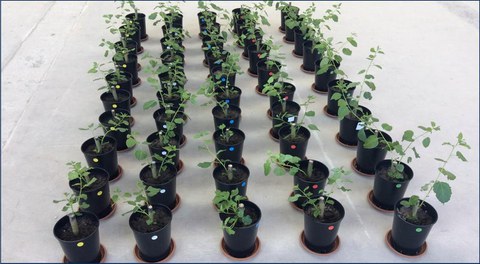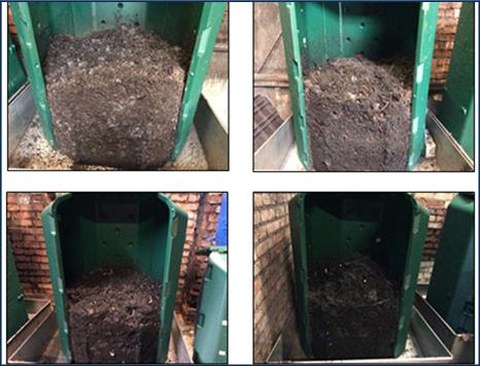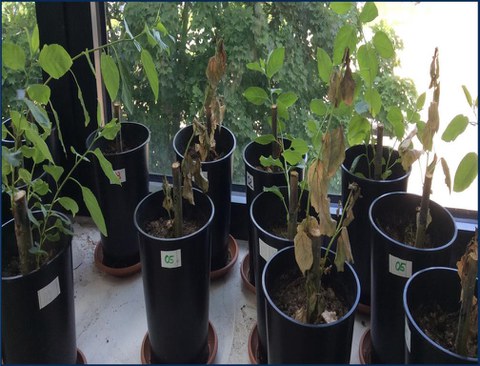Forschungsvorhaben "Deponieersatzbaustoffe"
Entwicklung hochflexibler Aufbereitungstechniken zur Produktion neuartiger, funktionalisierter Deponieersatzbaustoffe
Development of highly flexible processing technologies for the production of novel landfill substitute building materials
| Partner: |
- Landwirtschaftliches Verarbeitungszentrum Markranstädt GmbH, |
| Finanzierung: | SAB - Sächsische Aufbaubank Dresden |
| Laufzeit: | Januar 2017 - Dezember 2019 |
| Kontakt: |

Pflanzversuche mit verschiedenen Materialmischungen
Projektbeschreibung:
Ziel des Projektes ist die Entwicklung neuartiger Deponieersatzbaustoffe bestehend aus Klärschlammkompost, Substraten aus der Speisepilzproduktion und Abraummaterialien aus dem Berg- und Tagebau. Der produzierte Ersatzbaustoff soll in Rekultivierungsschichten von Deponien Anwendung finden.
Klärschlämme besitzen aufgrund ihrer stofflichen Zusammensetzung sowie des sich zuspitzenden Entsorgungsproblems ein hohes Verwertungspotenzial in Ersatzbaustoffen. Durch eine gezielte Behandlung kann deren Umweltgefährdungspotenzial reduziert werden. Verbrauchte Aufwuchssubstrate aus der Speisepilzproduktion (u.a. Champignon und Kräuterseitling) sollen als weiterer Zuschlagstoff die pflanzenphysiologischen Eigenschaften des Rekultivierungsmaterials verbessern. Durch eine gezielte Aufbereitung könnten nachhaltige Ersatzbaustoffe im Sinne der Kreislaufwirtschaft hergestellt werden.
Im Rahmen des Projektes wurden verschiedene Materialmischungen aus den oben genannten Materialien hergestellt, welche auf ihre Einsatzfähigkeit als Deponieersatzbaustoff getestet wurden. Hierzu wurden verschiedene Pflanzversuche und geotechnische Materialprüfungen an der TU Dresden durchgeführt.
Zu untersuchende Fragestellungen
Kann der Einsatz von Klärschlamm als Rekultivierungsmaterial eine sinnvolle Verwertungsstrategie darstellen?
Inwieweit ist die Verwertung von Klärschlamm außer dessen Verbrennung im Zuge der Novellierung der Klärschlammverordnung noch möglich?
Eignen sich Abfallstoffe aus der Speisepilzproduktion als Strukturmaterial für die Kompostierung von Klärschlamm?
Wie beeinflussen Pilzsubstrate die Komposteigenschaften (bspw. Wasserhaltekapazität und Nährstoffverfügbarkeit)?
Kompostierversuche
Es wurden drei verschiedene Kompostierversuche mit jeweils unterschiedlichen Kompostmischungen am Institut für Abfall– und Kreislaufwirtschaft (IAK) durchgeführt.
Die Mischungen bestanden in verschiedenen Zusammensetzungen aus entwässertem Klärschlamm, Strukturmaterial oder Siebabfall, sowie Champignon– oder Kräuterseitlingsubstrat.

Kompostierversuche am IAK
Pflanzversuche
Im Abstand von einem Jahr wurden zwei Versuchsreihen mit Pflanzversuchen am IAK durchgeführt. Hier wurde getestet, welche Materialmischungen (jeweils bestehend aus verschieden zusammengesetztem Kompost und Abraummaterial) sich am besten auf das Pflanzenwachstum auswirken.
Als Pflanze wurde der Pappelhybrid Max 3 verwendet. Die Versuche wurden als Topfversuch im Raum durchgeführt.

Pflanzversuche am IAK, 2. Versuchsreihe
Das Projekt wurde zum Jahresende, also im Dezember 2019 abgeschlossen.
Es kann zusammenfassend gesagt werden, dass die Beimischung von Pilzsubstraten zum Kompost keine Nachteile bringt, sich jedoch auch nicht signifikant vorteilhaft auswirkt.
